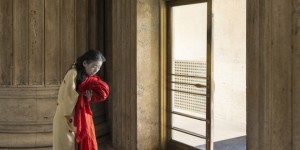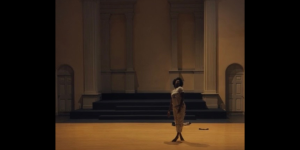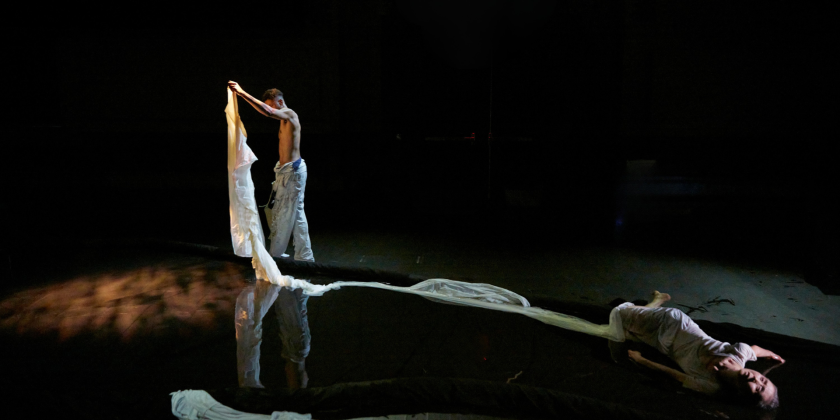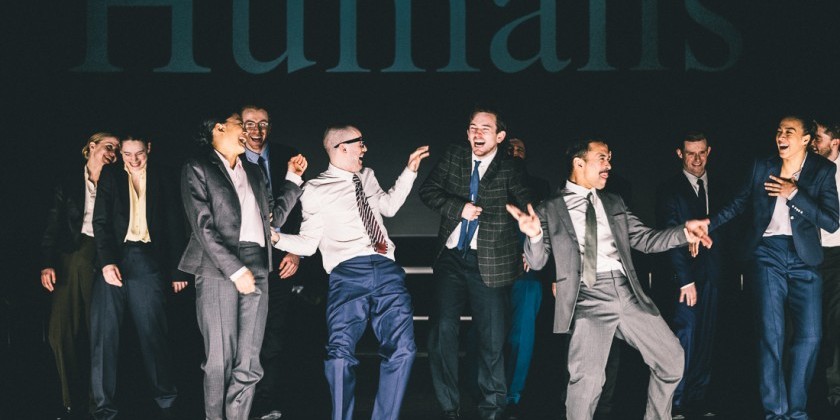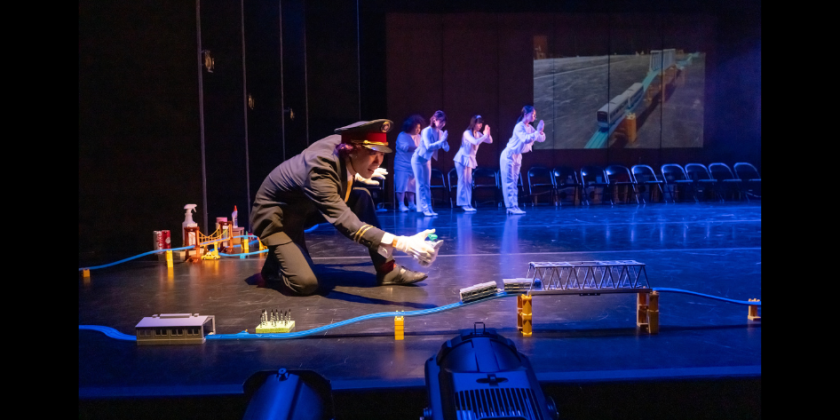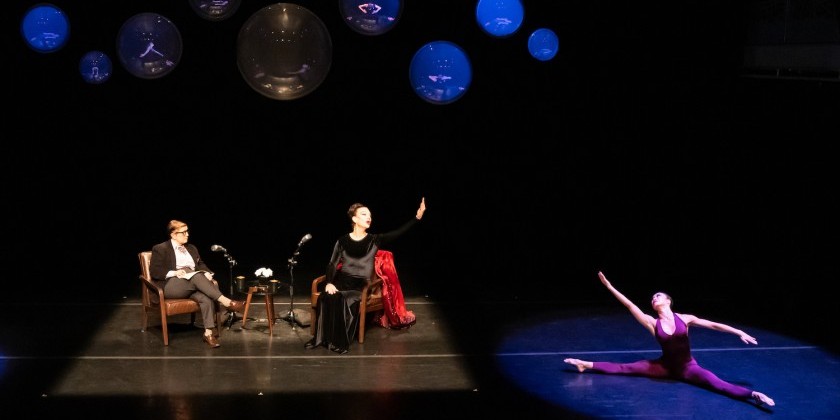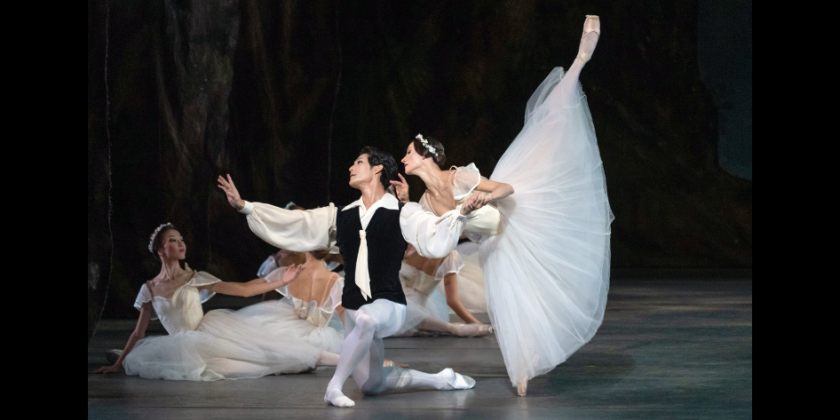Eiko Otake: A Body in Places - Part I
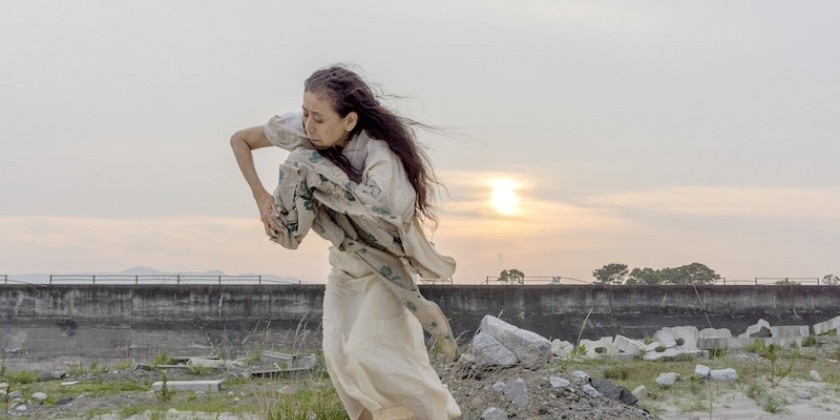
Programming runs through March 23. For the full schedule, click here.
Leaning against the iron railing and gazing down into a stairwell on a sunny morning in late February, a handful of people have assembled for a preview of Eiko Otake’s solo program A Body in Places, part of the extensive Platform of activities the Danspace Project has organized around the celebrated dancer this spring. Meeting in front of St. Mark’s Church, we marched southward and halted at this all-but-deserted spot on a cobblestone street in the East Village. I don’t see anything here at first, however, except a tell-tale pair of Japanese sandals left neatly outside the door to Dashwood Books, a shop below the level of the sidewalk.
It takes a moment to recognize the body on the floor.
Through the plate-glass window of the bookstore, shelves and scattered volumes organize the interior into dim, rectangular shapes. A dark mass in the foreground invites suspicion. It seems too large to be a cat drowsing by the window, but too irregular in outline to be a rug. Suddenly whatever it is moves, and a disturbing picture comes into focus. Eiko is lying sprawled on the floor, her body shrouded under a black kimono.
In this setting, however, Eiko doesn’t look like a performer, not even with her face and limbs painted stark white. The theatrical environment she usually shares with her partner, Koma, is absent this time. Gone is the silken dishabille incorporating feathers, bits of fabric and leafy detritus in which the dancers may come to suggest woodland creatures; the ancestors of humanity; or even spirits in a landscape. Instead Eiko looks like a woman who has suffered a seizure and lost consciousness while shopping, or, worse, like a homeless person so destitute she has spent a hard night camping on the floor of an empty bookstore.
Shifting she exposes her leg, and with her foot protruding stiffly her nakedness reminds us we are looking at someone human like ourselves. The rounded calf muscle and the toes seem insolently familiar. What is “our” leg doing in these destitute circumstances? Eiko continues slowly picking at our consciences. She lifts her chest while her head falls back, gripped by some unspoken urge. This woman is definitely not well. Her face a mask, she seems too self-absorbed to care if her strange behavior draws back a veil revealing the unpleasant facts of morbidity and death. She presents a sight that normally would be hidden from the public in a hospital ward, and, if glimpsed by accident, would make frightened viewers hasten away.
Instead, a man opens the door to the bookshop and we are invited to crowd into the small space beside her. We have permission to witness this woman’s misfortune up close. Just as Eiko’s style of “delicious movement” has the power to manipulate our perception of time, stretching or compressing it to fit the contours of emotional events, she also can manipulate our perception of space. Occupying the corner beneath a book counter, her dancing makes this tiny area unfurl like a vast territory. With the effort she requires to turn on one side; to slump and press her body against the counter; to shrink and then ever so gradually to roll around and prop herself against another wall of cabinets, she achieves a transformation. Despite its informality, this choreography suggests an epic journey possibly lasting a lifetime.
“My work is always very small,” Eiko tells me in an interview as she prepares herself for these events. “But smallness is a statement, too.” She explains that when she danced at the Fulton Center as part of the River to River Festival last summer, hundreds of people gathered to watch her stagger through the modern transit hub carrying an armful of weeds and swabbing the floor with a piece of antique red silk. “Generations of women” have worn that silk, Eiko says, which she continues to carry around, a flag of crimson peeking out from under her kimono. Viewers may associate the red material with menstrual blood or intestines, or simply recognize a symbol of protest. “With that red cloth, I do this motion of cleaning the floor,” Eiko says. “So metaphorically this red cloth has absorbed all the bad things from the world. But I cannot clean. The world is too dirty. I cannot clean it.” Making plans for this year’s Danspace Platform, Eiko told Danspace executive director Judy Hussie-Taylor that she wanted to avoid crowds and dance for audiences of individuals performing one-on-one.
“I am not dancing with Koma. I am not dancing with a big set,” Eiko says. “It means people become more important. I look at the people. I can see a person’s eye, and he or she knows I am looking. There’s a real strong sense of openness or exchange. The eye-to-eye gaze becomes extremely important to me; and I travel looking at people’s faces.
“It’s very practical in a way,” she continues. “Oh, you are here. Wow. I know you. Oh, no, I don’t know you. Who are you? This conversation happens without words. And I also decide how much space I occupy. In some places, I run blocks with this thing [the red silk]. Sometimes I’m in a very small place, in three rooms or one room.”




